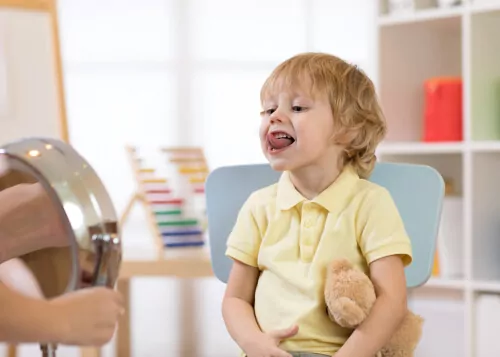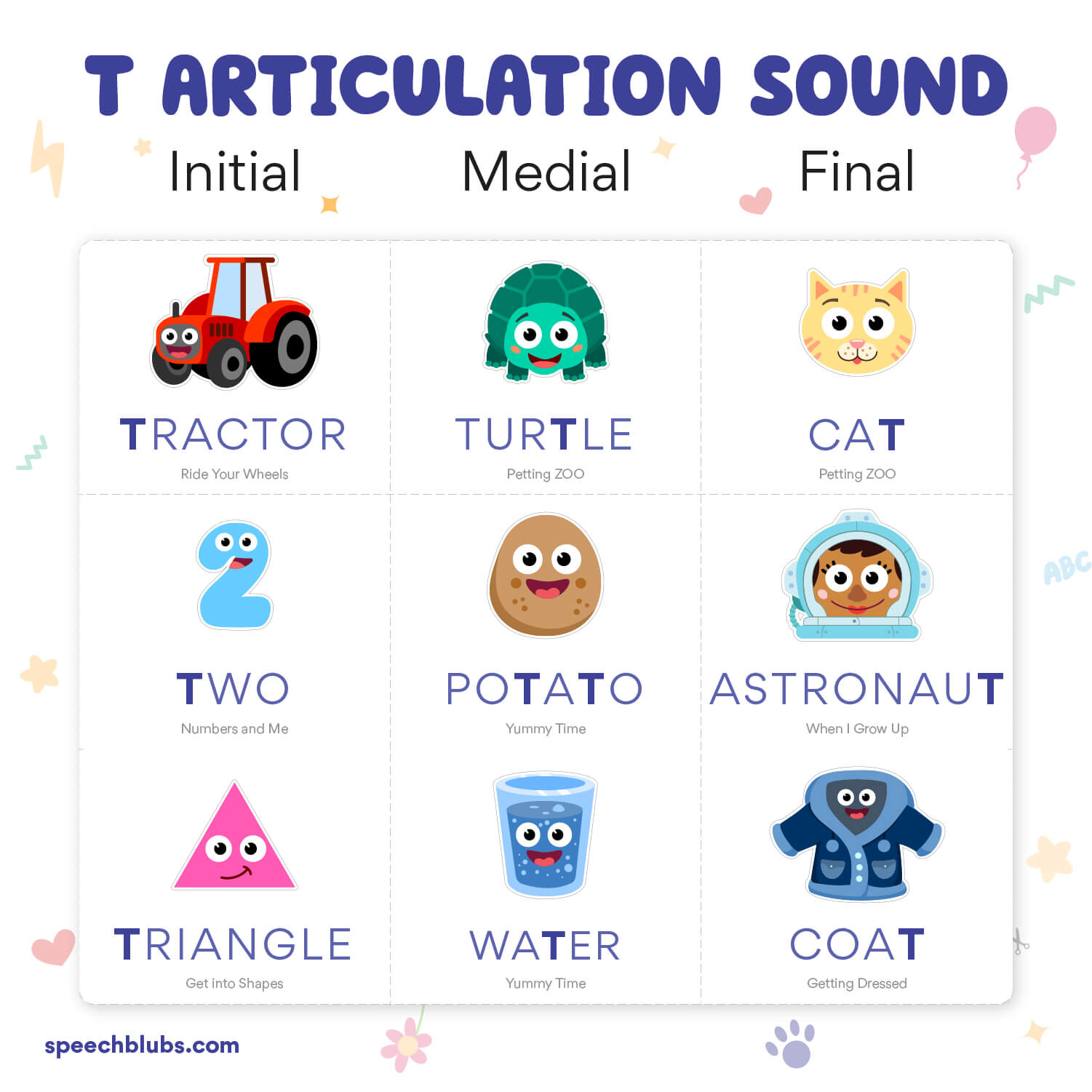T and D Sounds Articulation Therapy: A Guide for Parents
Feb 13, 2022 In all of my years of being a speech pathologist, I have found that if a child has difficulty producing the /t/ sound, they will most likely have issues producing the /d/ sound.
That is because both of these sounds are produced in the same location. The only difference is voicing – /t/ is voiceless and /d/ is voiced. If your child can produce a /t/ sound and not the /d/ sound you simply teach them to “turn on their voice” for the /d/ sound. Or if it is the other way around you teach them to “turn off their voice” by whispering the sound for the /t/.
Can Your Child Lift Their Tongue Tip?
The first thing you have to look at is if your child can lift the front part of his tongue (the tip) to reach the top of his mouth. If born with a tongue tie, this will be impossible for your child to complete.
Tongue tie surgery is a very simple and common procedure that will remove the small piece of skin that is connecting the tongue to the floor of the mouth. Once this procedure occurs, the child can lift his tongue to reach the correct placement.
Most children, however, are just confused as to where their tongue goes. This is why most children replace the /t/ and /d/ sound with the /k/ and /g/ sounds, which are created in the back of the throat.
Teach Your Child Where to Place the Tongue for /t/ and /d/
If lifting up the tongue tip is no problem, then it’s simply a placement issue. Show your child where their tongue should be positioned for each sound. This can be done with a mirror – it’s the most fun and effective because you can practice making silly faces.

Another way to get your child to reach that part of their mouth is to try stimulating the gums behind the front teeth (the alveolar ridge), and the tongue tip with a small toothbrush, then tell the child to place the tongue tip behind his front teeth. Once the tongue is in place, have him try to imitate a /t/ or /d/ sound all by itself. This should produce the sounds.
Teach Your Child How to Raise the Tongue for /t/ and /d/
If raising the tongue is difficult, I like to use an incentive to get the child motivated to try. I will stick things like marshmallow or peanut butter right behind their teeth. Then, I ask the child to taste the food. Obviously, in order to taste it, then they need to lift their tongue. This can be done as a game, as well.
Blind fold your child before introducing the food. They have to guess what you have on the roof of their mouth. Once the tongue tip is in place, have them try to say the /t/ or /d/ sounds. You might say, “Make the sound of a clock, t-t-t-t-t-t.” Out of all of the therapy tips and tricks I give, this is one of the most successful articulation tips I can give parents.
Tongue Strengthening Exercises
If you are currently working with a speech pathologist, they will perform an oral motor examination prior to starting therapy. This is where they will look at all of the structures in and around the mouth area. If anything is weak, they will give exercises to do at home in order to strengthen that particular area.
One way to work on strengthening the tongue muscle is to have the child hold a cheerio, or smartie on the alveolar ridge with his/her tongue tip. Play a game where they hold it up while you count to 10 then they can eat it. This typically works well with children who are 4 years of age and older. You can do it with smaller children – just make sure you don’t use anything that they can choke on.
Moving Into Syllables
Once your child can produce the /t/ or /d/ sound in isolation, it’s time for you to introduce syllables. For this, have your child add vowels to the end of the sounds. For example, “to, tea, ta, ti, ate, it, aught.” You can have the sound in the beginning or end of the syllable and switch it up between /t/ and /d/.
Moving Into Words
Your child has mastered syllables and is ready to produce the sounds in words. Below are 6 links from Mommy Speech Therapy to use when working on the /d/ and /t/ sounds. Download the picture cards of words beginning with the /t/ and /d/ sounds, ending with the /t/ and /d/ sounds or with /t/ or /d/ occuring in the middle and work on them at home. I suggest making a game out of the cards – like, Bingo or Tic-Tac-Toe.
- /t/ in the initial position of words
- /t/ in the medial position of words
- /t/ in the final position of words
- /d/ in the in initial position of words
- /d/ in the medial position of words
- /d/ in the final position of words
How To Play Articulation Bingo?
- Use the button below to download our Articulation Bingo Board
- Print out the board and give it to your child or cut out the pictures and put them into a bag
- Let your child pick a word from the board / bag
- Find the word in Speech Blubs App and practice it, play with fun filters and watch educational videos
- Your child is a winner when he practices three pictures in a row (across, down, or horizontally) or the entire board
Boost Your Child’s Speech Development!
Improve language & communication skills with fun learning!

Moving Into Sentences
You’re almost through the entire hierarchy of articulation therapy. Once a child is consistently and accurately using the sounds in words, put them into sentences.
For example with /t/ words you might use the sentence “Talk to the _________.”
Fill in the blank with the initial /t/ words you have been practicing, “Talk to the tree,” or “Talk to the tiger.” It’s important to remember that your child may master one position of the sound, but not the others. It’s ok to be working on /t/ in the initial positon in sentences, but still be on syllable or word level with the other two positions.
Stories and Conversation
The last and final step of therapy is stories and conversation. Have your child read aloud to you and talk to you about their day and what they are doing. If your child cannot read, have them make up silly stories to tell you and see how intelligible their speech is.
Once they are good talking to you in stories, then you are good to move into conversational level. It is at this point you can correct your child if they forget to pronounce the /t/ and /d/ sounds spontaneously.
Each child will progress through therapy differently and at different rates. Don’t compare your child to anyone else’s and be patient!
If your child has difficulties with other sounds, here are the articles that can help you with speech therapy and articulation activities ideas:
- Articulation Therapy: An All-in-One Guide for Parents
- B Sound Articulation Therapy
- H Sound Articulation Therapy
- JJ and CH Sounds Articulation Therapy
- L Sound Articulation Therapy
- Lisp Articulation Therapy
- M Sound Articulation Therapy
- N Sound Articulation Therapy
- NG Sound Articulation Therapy
- R Sound Articulation Therapy
- S Sound Articulation Therapy
- SH Sound Articulation Therapy
- W Sound Articulation Therapy

